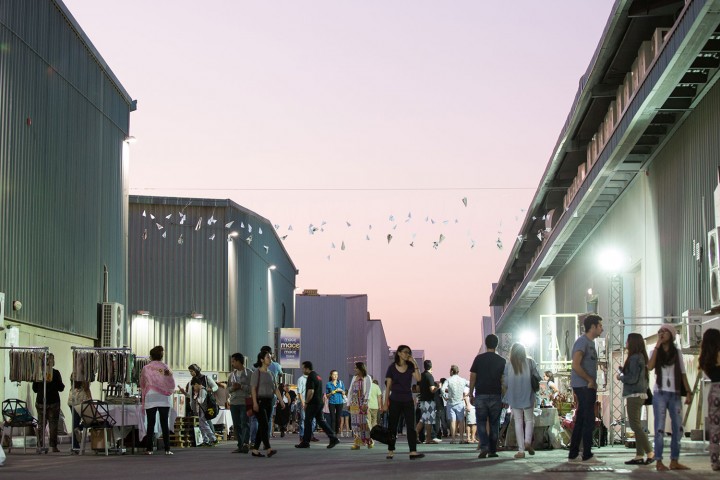Mr. Abdelmonem bin Eisa Alserkal gets edgy when he’s called a patron of the arts. Unassuming by nature, discreet by upbringing, he has nonetheless masterminded one of Dubai’s most dynamic cultural assets — the eponymous gallery “neighborhood” set in the grimy underbelly of the city’s industrial zone like some cool art oasis. From a cluster of galleries in 2007 dotted between garages and tire shops, Alserkal Avenue is now poised to double in size. As of Autumn 2015, some 76,000 m2 of new, Hollywood-back-lot-style spaces will welcome international heavyweights like Leila Heller Gallery, as well as some local luminaries, such as decade-old The Third Line. This ambitious construction has been mirrored by an equally exuberant programming activity, the most visible of which was the Safina Radio Project — a boat-cum-recording studio navigating Venice waterways during this year’s Biennale.
Mr. Alserkal’s snug, understated office, enlivened by Tintin paraphernalia and Paul Smith doodads, belies his position in one of the United Arab Emirates’ most enterprising families, instrumental in establishing the country’s utilities and infrastructure. Yet for all its industriousness, the Alserkal family is decidedly low-key. True to his pedigree, Mr. Alserkal does not trumpet his achievements, but rather embraces the challenges ahead.
What does an arts “neighborhood” mean today? If we look at Paris’s 13th arrondissement, the East End in London or Milan’s Lambrate, they are dwindling landscapes compared to what was planned. What sustains your belief in this format in Dubai?
The neighborhoods you mention are scattered. Here, we are all under one family, one management. The first part of Alserkal Avenue, which started in 2007, grew organically, alongside the development of Dubai’s art scene. As this scene evolved, we were approached by a lot of new talent who saw Alserkal Avenue as a place where they wanted to present their ideas. They understood the value of community support, and they wanted to be part of it. The members of the initial community wanted more space, so the new expansion stemmed from this demand. It is a curated expansion, so it provides continuity to the community that has existed since 2007. It will be more sustainable than the neighborhoods you mention.
Why are you investing so heavily in international visibility with projects like the Safina Radio Project?
I believe we are providing a platform for regional and local initiatives — artists, art galleries, creative — to be visible internationally. We have always housed homegrown talent. Now we are extending the platform for them to participate more deeply in the international art world. In this respect, we are acting more like an arts organization. We have done well in supporting the commercial side; now we want to contribute to supporting actual arts creation through our commissions, and to supporting artists internationally through our galleries. [At Art Basel Miami Beach in 2014, Alserkal Avenue supported Jacob’s Ladder — a performance work, referencing helicopter evacuation in conflict zones, by artist Shahpour Pouyan, represented by Alserkal-based gallery Lawrie Shabibi — Ed.]
Is this a new positioning? Has Alserkal Avenue outgrown its role as “neighborhood” to become a privately endowed institution?
We want to pursue a new role as an arts organization. There are still many gaps in the Dubai art scene. We want to create opportunities for the talent base here, and the possibilities are endless. We achieve this through our homegrown programs like the Safina Radio Project, our joint commissions with Art Dubai and our own commissions, our partnerships with foundations abroad, our educational projects, the upcoming artists’ residencies… It is no longer about the physical space, but about this content we are building, the substance we didn’t have before. We are no longer a neighborhood. We are becoming an arts organization. That is where we want to be.
Do you feel there is an overlap between what you intend to do and initiatives by other local players like Art Dubai, with its own agenda of residencies and commissions?
Everyone is doing their own part — Art Dubai, Dubai Culture — and there is an opportunity for us as an arts organization. In terms of commissions, for example, our mission is very clear: to support experimental media that is not at all commercially supported — experimental work, sound installations, public art, performance. But we are also building a cultural destination. Among the new initiatives will be a theater, art cinema and educational spaces. So it expands the arts.
Which is more important for you: that people engage with the cultural content in Alserkal Avenue, or that it is seen as a desirable destination?
Content is extremely important for us, but the programming is new. In the first year it will be about forming our own voice. We want to be part of the art history in this part of the world. Ten years from today, we want people to refer back to commissions we did. We want to be part of that timeline. But we are just starting.


